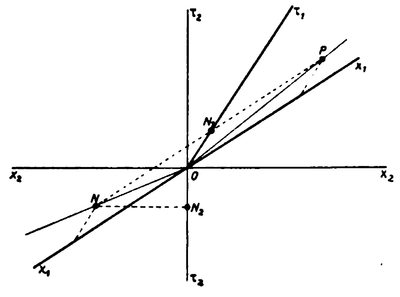Translation:On v. Ignatowsky's Treatment of Born's Definition of Rigidity II
On v. Ignatowsky's Treatment of Born's Definition of Rigidity. II.[1]
By P. Ehrenfest.
For increased clarity, I allow myself the following conclusions:
1. Is a body, satisfying Born's rigidity definition, capable of passing from rest to uniform rotation? – I, Herglotz, Noether have shown[2]: No. v. Ignatowsky claimed[3] that from his calculations it follows: Yes. My protest[4] forced him to admit[5]: a) that no such thing follows from his relevant calculations, b) that his claim is wrong per se.
2. Is a Bornian body capable of executing curvilinear-translatory motions? – Herglotz and Noether have shown: Yes. – v. Ignatowsky claimed that it follows from his calculations, that only rectilinear-translatory motions are possible. – Noether's protest by letter forced him to admit[6]: a) that no such thing follows from his relevant calculations, b) that his claim is wrong per se.
3. Provided, that a signalization process is of such kind, that a couple of observers (mutually at rest) can say about it: With the aid of process we can send to each other signals with superluminal velocity in all direction. Would this mean "to telegraph into the past" for an observer who is conveniently moving with respect to them? – With a simplicity and clarity, which should have prohibited any further misunderstanding, Einstein showed:[7] Yes. Despite of editorial warning from W. Wien[8], v. Ignatowsky published his opposite opinion that is evidently wrong.[9]
In his paper "The Rigid Body and the Principle of Relativity", v. Ignatowsky arrives at no other new results than at those three incorrect ones that were previously put together. Then it is surely understandable, that the author – leaving the treatment of the "relative-rigid" body which is all too precisely defined – now turns himself[10] to the stimulating-flexible research area of the "relative-elastic" body. In how far the series of formulas published in this direction by v. Ignatowsky for the time being, has something to do with Planck's program which he repeatedly cites, can surely be seen in the not too distant future.[11]
St. Petersburg, March 15, 1911.
(Received March 17, 1911.)
- ↑ I: this journal 11, 1127, 1910.
- ↑ P. Ehrenfest, this journal. 10, 918, 1909; G. Herglotz, Ann. d. Phys. 31, 393, 1910; F. Noether, Ann. d. Phys. 31, 919, 1910.
- ↑ Ann. d. Phys. 33, 1127, 1910.
- ↑ This journal 11, 1127, 1910.
- ↑ This journal 12, 164, 1911.
- ↑ Ann. d. Phys. 34, 373, 1911.
- ↑ Jahrb. d. Radioaktiv. 4, 411, 1907.
- ↑ See footnote to § 6 in W. v. Ignatowsky, Ann. d. Phys. 33, 607, 1910.
- ↑ The graphical representation in the Minkowskian -plane admits to conveniently overview the state of facts. The fundamental coordinate system , is chosen from the standpoint of observer . is the "world-line" of observer as protocoled by . is the epitome of all world-points being simultaneous with world-point from the standpoint of . and are lines representing the path of two signals, about which would say: "I'm signaling from into both direction with a velocity being much higher than the speed of light" ( and indeed nearly coincide with the "simultaneity line" of observer , i.e., they are "nearly fast to him). and then have to judge about the couple of world-points and as shown by the drawing, in the following way:
: Event is the cause of with .
: Event is the cause of .
This conclusion from the existence of superluminal velocities, is exactly the one alluded to by Einstein (l.c.), and for which it was recently coined the slogan "to telegraph into the past". – If v. Ignatowsky would not only have thought about his explanations (of § 6 in his paper) for the case of fast, but also for the case of "nearly fast" propagation velocities, and followed the two-sided signal propagation from the middle point of his rod, then he surely would have seen that everything written by him in § 6 and lectured in Königsberg, regarding Einstein's remark on superluminal velocity, was wrong. – Incidentally, that the special arrangement given by v. Ignatowsky at that place as an example of signalization, cannot at all be seen as signalization, was additionally shown by Laue (this journal 12, 85, 1911).
- ↑ This journal 12, 164, 1911.
- ↑ The things said by Varičak (this journal 12, 168, 1911) about the tracing-images of moving Bornian bodies, I consider as incorrect. In the interest of clarification of the question, together with shortening the discussion as far as possible, I will discuss this with Varičak by letter, so that we can already publish together the correct state of matter.
![]()
![]() This work is a translation and has a separate copyright status to the applicable copyright protections of the original content.
This work is a translation and has a separate copyright status to the applicable copyright protections of the original content.
| Original: |
This work is in the public domain in the United States because it was published before January 1, 1929. The longest-living author of this work died in 1933, so this work is in the public domain in countries and areas where the copyright term is the author's life plus 90 years or less. This work may be in the public domain in countries and areas with longer native copyright terms that apply the rule of the shorter term to foreign works.
Public domainPublic domainfalsefalse |
|---|---|
| Translation: |
This work is released under the Creative Commons Attribution-ShareAlike 3.0 Unported license, which allows free use, distribution, and creation of derivatives, so long as the license is unchanged and clearly noted, and the original author is attributed.
Public domainPublic domainfalsefalse |



















